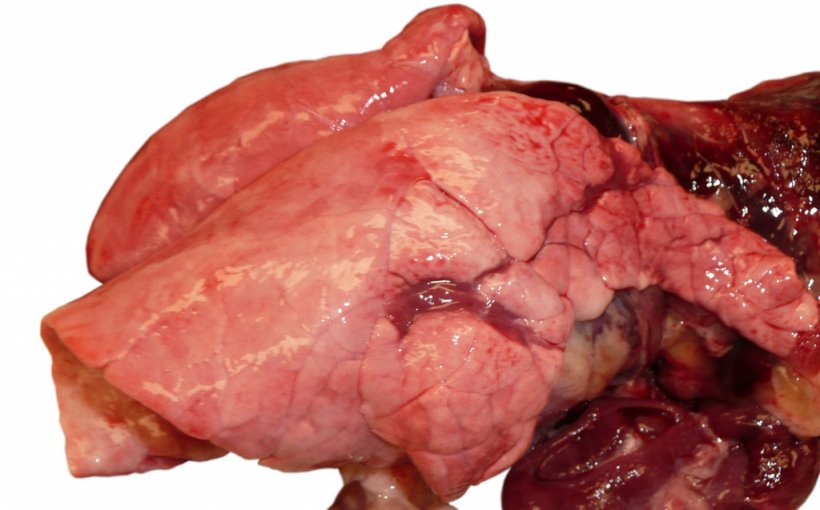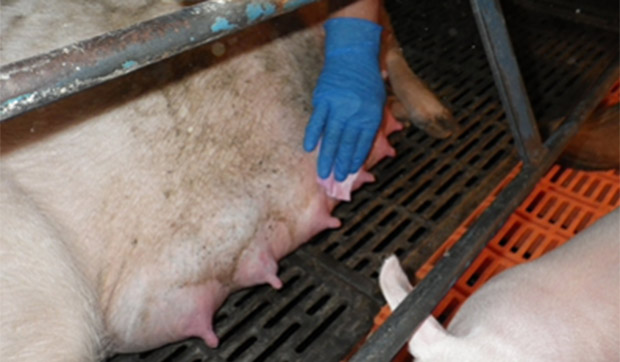Pneumonia, fever, coughing and sneezing caused by influenza A virus (flu) in pigs are common and can result in significant economic losses for producers. Flu viruses in pigs have changed significantly during the last few decades with the introduction of multiple viruses from humans and birds. This has resulted in an increase in viral genetic complexity that has made flu infections particularly difficult to control. Flu never seems to go away in some herds and that is because of the virus itself but also because there are groups of pigs able to maintain and spread the flu virus. One of those groups is the piglets prior to weaning. Piglets may be infected but may not show any signs of disease, and as a result, are silent spreaders of flu. Then, at weaning, a small, but significant, percentage of the piglets can be subclinically infected with flu, meaning they appear healthy but are shedding flu at the nursery or wean-to-finish site.
Piglets are born free of flu but in endemically infected farms, those farms that have flu problems continuously, piglets usually become infected between processing and weaning, and commonly we see levels of flu going up during their second week of life. The occurrence of flu positive piglets is highest at weaning and thus piglets are not just a source of flu infections in the breeding herd but also a major source of infection to growing pigs (Picture 1). Understanding how piglets become infected while still on the sow and preventing piglets from getting infected in the first place is necessary to decrease the risk of spreading flu to other farms. But controlling flu during the pre-weaning period can be very difficult because every day, new litters of pigs are born that are susceptible to flu and can really increase the virus levels in the farrowing rooms. Even when we do our best to protect the piglet by vaccinating the sow and making sure all piglets get their protective colostrum, the piglets still have flu and can spread it to their littermates and other pigs they contact. That is because the protection the sow gives to the piglet, known as the maternal immunity, is not perfect. Maternal immunity is important and helps improve the performance of infected pigs, helping them get through their flu infections and become robust piglets. Sow vaccination is also important to reduce the prevalence of flu-infected pigs at weaning but sow vaccination alone is not enough to consistently wean flu negative pigs or pigs with very low levels of flu.


At the University of Minnesota, we have been measuring the impact of piglets on the spread of flu for years. We found, in a study of 52 swine breeding herds in the US, 23 herds (44%) tested IAV RT-PCR positive at least once during a six month study period. Groups of piglets from those herds also tested positive for flu at weaning about 25% (75/305) of the time. In a different study, out of 34 farms studied for over 5 years, all sow farms tested positive for flu at one time or another and the level of flu infection in the groups of weaned pigs ranged from 7 to 57%. More importantly, approximately 28% (427/1523) of groups of pigs tested positive at weaning. With almost a third of the weaned pigs flu positive when placed in the nursery, the impact of these flu positive piglets can be tremendous for the other pigs they are placed with when growing.
Basically, piglets have about 21 to 28 days to become flu infected depending on how old they are at weaning. Then, the question is when and how the piglets become infected. Direct nose to nose contact is one of the main routes of flu transmission, but other routes (ie., airborne) are important as well. Our group has studied sources of flu exposure to piglets prior to weaning. Besides pig to pig transmission (i.e mixing of pigs), including the sow, fomites such as surfaces of crates, contaminated materials and the air can contain infectious virus.
A recent finding by our group was the detection of flu virus in the udder skin of lactating sows (Picture 2). Sows that have suckling piglets infected with flu, will likely become contaminated or infected with flu. Infected piglets will likely deposit their contaminated nasal and oral secretions on the skin of the sow. This was an important observation that has management implications since sows that adopt piglets (ie; nurse sows) may represent a source of infection to the newly adopted pigs. In deed we have showed both experimentally and under field conditions that nurse sows play a role at maintaining influenza infections endemic in breeding herds. Piglets adopted by nurse sows selected at weaning, had higher likelihood to become flu infected and tested flu positive faster than pigs reared by the biological dams. These studies indicate the importance to understand the impact of management practices on disease transmission.

Ultimately, the successful control of on-going flu infections in growing pigs will depend on the sow farm’s ability to wean a negative pig or a pig that does not pose a risk of spreading flu at weaning. Therefore, it is extremely important that we have a full understanding of what factors contribute to flu infections in breeding herds. Translating the research to on-farm use and applying new tools when they become available will be important to control flu in swine breeding herds and protect the piglets.






